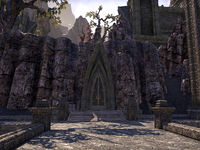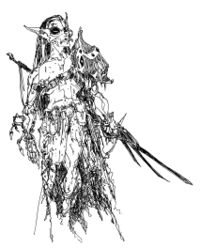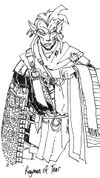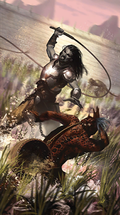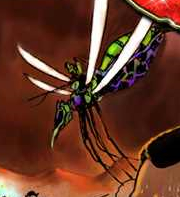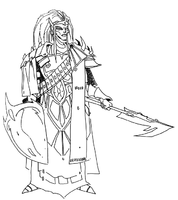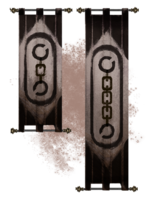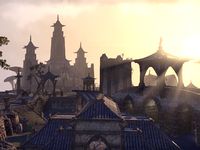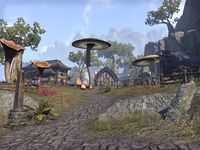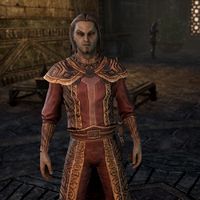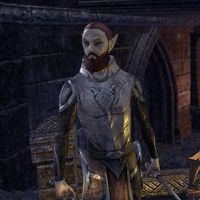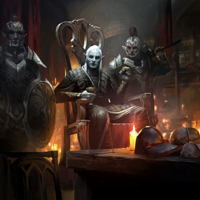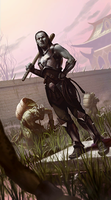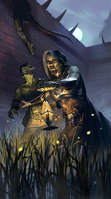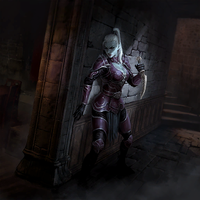Lore:House Dres
- House Dres is an agrarian agricultural society, and its large saltrice plantations rely completely on slave labor for their economic viability. Always firm Temple supporters, House Dres is hostile to Imperial law and culture, and in particular opposed to any attempts to limit the institution of slavery. – Great Houses of Morrowind
House Dres (also called Clan Dres)[1] is one of the Great Houses of Morrowind, with presence only on the mainland. It governs the Dres District of southeastern Morrowind from its ancestral capital city of Tear, also called 'Dres' and noted for its proximity to Black Marsh.[2] The district included parts of the fertile Deshaan plain, the southern areas of the Telvanni Peninsula, and bordered the Indoril District, Hlaalu District, and the swamps and marshes of the Black Marsh regions of Shadowfen and Thornmarsh.[3][1] In the mid-Second Era, House Dres also controlled the cities of Ebonheart[4] and Kragenmoor[5] in central Morrowind. At least once, House Dres managed to gain a minor foothold in the Telvanni lands of the eponymous peninsula.[6][7] House Dres has had no recorded settlements on the island of Vvardenfell. Despite this, some Dres families lived on the island in ancient times before relocating to the mainland, and some Dres ancestral tombs may still be found on the isle. Among them is the ancient Dreloth clan, a cadet branch of the Great House, as well as the Maren, Othrelas, Serano, and Velas clans.[8][9] It was formally established as a Great House before the middle of the First Era by Grandmaster Thalthil Dres after a slave-raid over Thorn.[10][11][12]
The Dres have a mainly rural but still very wealthy agrarian agricultural society, maintaining vast saltrice plantations on the plains and marshes surrounding Tear.[3] The Dres were also the Dunmer who shipped the majority of slaves to the other Great Houses (on par with the Indoril and Telvanni),[13] keeping thousands of captives, mostly Argonians and Khajiit in their infamous slave-pens of Tear and the surrounding plantations.[1] The Dres are also known among the Great Houses for maintaining a persistent tradition of Daedra worship and ancestor reverence, their staunch support of unity between the Great Houses, and their emphasis on inter-House relations and the improvement of Dunmeri society as a whole.[11][14]
Saint Llothis the Pious is the patron saint of House Dres.[15]
History[edit]
First Era[edit]
- "The isolationist stance of House Dres was instilled in its customs and world outlook from the very beginning. Not only do we consider the other cultures and races to be inferior to the Dunmer, we deem any extended contact with them where we were not in total control to present a danger to Dunmer society. Ideas, like a plague, can spread without warning and prove to be impossible to contain. Instead, we should concentrate on inter-House relations and improving the position of the Dunmer to make our society stronger and eternal." – Understanding House Dres
House Dres was founded in ancient times, formally established after a successful slave-raid on Thorn by Grandmaster Thalthil Dres before the middle of the First Era.[10][11][12] The House has existed since the time of the Chimer and the First Council.[16] By the 84th year of the Golden Peace, the Dres had already built their fortune on saltrice plantations and slave labor. They prided themselves on maintaining a persistent tradition of Daedra worship and ancestor reverence. According to Grand Historian Solamar Dres, the isolationist stance of House Dres was instilled in its customs and world outlook from the very beginning.[11] It is said in Vivec's Sermons that the Chimeri hero, Dres Khizumet-e fought against the Nords in the Conquest of Morrowind during the Skyrim Conquests in the early-First Era. He was devoured by the demon chieftain, CHEMUA and his spirit was sent to assassinate the Hortator, but it failed. Chemua could turn the rain of Veloth into bile and destroyed six Chimeri villages before he was slain by Vivec and the Hortator.[17] The now extinct Cantemiric Velothi settled in northeast Argonia near modern Dres territory, and it is said by Dagoth Ur that ancient Chimer territories were "stolen" by Argonia, possibly referring to House Dres territory once stretching as far south as the formerly Dres city of Thorn.[18][19]
Prior to the War of the First Council, thirty of the most influential and revered Chimer Clans worked together to build the fabled Library of Andule, a grand repository containing the genealogical records related to the earliest Velothi settlers and other assorted knowledge about the earliest history of the Great Houses.[20] Four of the thirty Revered Families hailed from House Dres; the Maren, Othrelas, Serano, and Velas Clans.[9] The locations of the tombs were presumed lost in the aftermath of the War of the First Council, along with the Library of Andule and the records contained within.[20] The four tombs were rediscovered in 2E 582, alongside the other twenty-six families and the Library of Andule itself.[21]
Like the rest of the Great Houses, House Dres participated in the Battle of Red Mountain during the War of the First Council under the leadership of Hortator Indoril Nerevar around 1E 700.[16]
Over time, House Dres solidified their position as Morrowind's agrarian powerhouse, claiming that their agricultural might fed Morrowind and providing the majority of the foodstuffs necessary for the existence and continuation of Dunmer society. The House's vast wealth was drawn from this agricultural dominance, supplemented "nicely" by their control of the slave trade. They believed that the Dunmer should concentrate on inter-House relations and improving the position of Morrowind, in an effort "to make our society stronger and eternal".[11] They have been at the forefront of the Dunmeri slave trade since the middle of the First Era.[12]
House Dres adopted the linked chains of a slave's manacles as their heraldry, referencing the source of their power and their dominance of the slave trade. They likewise adopted the color grey as a designation.[22][12]
In the middle of the First Era, the burial crypts of the noble Dres family were excavated beneath the city of Kragenmoor by Argonian and Khajiiti slaves.[23]
At some point during or prior to the eleventh century of the First Era, the Dunmer of House Indoril and House Dres came into a little-known conflict with the First Empire known as the War for Silyanorn - the Ayleid site that would one day become the city of Stormhold. The war included the naval Battle of Tear Harbor, wherein the Indoril fleet was defeated by the Imperial fleet offshore of the House Dres capital city. The victorious Imperials claimed the former Indoril flagship and christened it the Dominus Fatum. In 1E 1033 during the reign of Empress Hestra, the vessel's crew would go on to capture the infamous Argonian pirate Red Bramman in Blackrose by braving the uncharted rivers of Shadowfen, though the Dominus Fatum was lost to the bogs of Murkmire in the process. The ship's wreck remained mostly intact for over two thousand years and was re-discovered in 2E 582, suspended by a large tree in Murkmire.[24] The outcome of the war is unknown, but Stormhold - built upon the ruins of Silyanorn - was under Dunmer control as late as 2E 572.[25][26][27]
Great House Dres' role during the eighty-year Four-Score War against the Second Empire is unknown.
Second Era[edit]
- "To spread culture and truth to the benighted: this is our commitment and burden." — Mottos of the Dunmeri Great Houses
During the Second Era, House Dres controlled the city of Kragenmoor in Stonefalls, where Grandmaster Omin Dres, leader of the House in the mid-Second Era, resided as of 2E 582. Dres Councilman Drathus Othral ruled Ebonheart on the Dres' behalf, though Redoran, Hlaalu, and Indoril also held significant influence in the city. The House also maintained plantations around the capital of Mournhold.[28] In northern Black Marsh, the cities of Stormhold and Thorn were both under Dres rule. Stormhold served as the Dres' primary foothold in Black Marsh,[27][25][26] while Thorn was home to Councilman Glathis Dres, and was surrounded by slave-operated saltrice plantations.[29] Despite the opulence and wealth of Dres nobles, thieves around this time feared the Great House, encapsulated by the popular mantra of "Don't cross the Dres". Dres justice was rumored to not bother with Ordinators or local guardsmen.[30] In Black Marsh, House Dres employed the Argonians of the Archein tribe in the capture and selling of other Argonians.[31][25][29]
In 2E 559, a dispute over a House Hlaalu trading post in contested territory erupted into an armed conflict known as the War of Two Houses. The so-called "war" consisted of only one battle, fought by House Dres mercenaries and House Hlaalu guards at the trading post. Despite outnumbering the Hlaalu five-to-one, the conflict ended with a decisive House Hlaalu victory when the leader of the Hlaalu guards, Purilla Falen, defended a portal that allowed a full cohort of Hlaalu battle-merchants to swarm the Dres mercenaries.[32]
Some years before the battle of Vivec's Antlers, the Argonian hero-to-be Keshu the Black Fin travelled to the Dres-controlled city of Stormhold in Black Marsh. After two of her companions were abducted by House Dres slavers, Keshu - with the assistance of a younger Jorunn the Skald-King - stormed the House Dres slaver's enclave on the edge of the city and rescued their companions. The experience prompted Keshu to cobble together a small band of militant Argonians informally known as the Black Fin's Legion, who proceeded to wage "war" against House Dres by raiding Dres slave caravans headed for Morrowind for a number of seasons. The conflict abruptly ended in 2E 572 when the Black Fin's Legion answered a call for aid from Jorunn the Skald-King, and participated in the battle of Vivec's Antlers, and subsequent alliance.[27]
Shortly before the Second Akaviri Invasion in 2E 572, Councilman Glathis Dres was murdered in Thorn by his Argonian slave, Heita-Meen, who would go on to lead the force of Argonian Shellbacks at the Battle of Vivec's Antlers.[29] After the defeat of Ada'Soom Dir-Kamal's Akaviri forces, the Ebonheart Pact was signed. In recognition for their assistance, the Great Houses of Morrowind (with the exception of House Telvanni) liberated their slaves. House Dres released the slaves of allied Pact races, most noteably the Argonians,[33] but continued to unofficially maintain their slave-holding ways with non-Pact races.[34][35] The Dres were noted for the "persistent slander and calumny" that surrounded their membership in the Ebonheart Pact in the years that followed. They nevertheless remained loyal to the alliance and all it stood for, and 'officially' refrained from condoning the perpetuation of slavery within the areas they administrated.[UOL 1] After the eruption of the War of the Three Banners in 2E 580, House Dres' warriors would be among those that fought for control of Cyrodiil and the White-Gold Tower.[36] As a result of the Ebonheart Pact's creation, the formerly Dres-ruled Black Marsh cities of Stormhold and Thorn were returned to Argonian control, with local tribes benefitting from cessation of the raids of the Dunmeri slavers to the north.[26][UOL 2]
In 2E 573, the Dres capital city of Tear suffered a series of disasters, including summer chills, a flood, a miasma that settled over the city, fouled drinking water, and plague. With the healers of the city overwhelmed, and nearby communities declining aid for fear of spreading the plague, the healer Rindral Thirano was driven to bargain with the Daedric Prince Peryite for the city's survival. At the cost of taking all the ills of the city upon himself, Rindral ensured Tear's recovery and good health.[37]
During the Daggerfall Covenant's invasion of Stonefalls in 2E 582, House Dres struggled to maintain order in Ebonheart.[38] In Kragenmoor, a grief-stricken Tanval Indoril's Vanguard marched on Kragenmoor and took Grandmaster Omin's son Sen hostage, in exchange for access to the peak of Tormented Spire and the Brother of Strife, Sadal. The Vestige's arrival in the city shortly afterwards saw Sen Dres released.[39] At the behest of Grandmaster Omin, the Vestige proceeded to slaughter the remaining Indoril Vanguard in retaliation for their transgressions.[40] In Deshaan, Houses Dres and Hlaalu clashed around the ruins of Mzithumz,[41] while Dres members unwittingly furthered the agenda of the Maulborn Cult in Mournhold.[42] In the Telvanni Peninsula, House Dres agents conducted "Operation Siphon" - a long-term intelligence gathering scheme - against their "hated rivals" in the House Telvanni leadership near the settlement of Ald Isra on behalf of Councilor Ralds.[43][44][45] The Operation was partially thwarted when the Telvanni Masters became aware of one of the two spies in their midst, and a Morag Tong assassin was sent to dispatch the individual.[46]
Bounty Hunters in the employ of House Dres during this time were presented with writs of arrest that authorized them as an agent of the Dres commissioned by the Hortator of the Great House to re-acquire "live property". Said agents were fully authorized to distribute appropriate compensation to any guard command willing to allow the agent to go about the business of the re-acquisition of missing "property" without hindrance.[47] Despite their xenophobic outlook, the Dunmer of House Dres were known to trade with organizations from outside Morrowind during the mid-Second Era. In 2E 582, Grandmaster Omin Dres sent the Darkvale Coster, a large Dominion-affiliated merchant group operating out of Auridon, a missive indicating his interest in commerce. The Darkvale Coster, in turn, sent a representative bearing trade goods, such as potions, to Kragenmoor.[48]
At some point after 2E 850 and before 2E 864, the Khajiit S'rathra funded a raid on a slave camp near Tear with his own wealth, with the objective to liberate Khajiiti slaves from the camp. Among the participants of the raid was the famed Redguard hero, Cyrus.[49]
In the late Second Era, Tiber Septim's legions turned their eyes towards Morrowind. Following House Indoril's lead, House Dres and House Redoran swore to resist the western invaders to the death. However, the Dres and Indoril advocated allowing the western invaders to enter the interior of Morrowind, where they'd battle them via a guerrilla war. With the Redoran manning the western borders alone, the Telvanni remaining neutral, and the Hlaalu advocating accommodation, Morrowind was disunited. When Vivec signed the Armistice after only a handful of skirmishes, House Dres grudgingly bowed to the will of the Tribunal, but only with strong provisions protecting slavery.[50]
Third Era[edit]
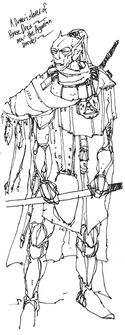
- "House Dres represents the past of pre-Tribunal Great House culture, a persistent tradition of Daedra- and ancestor-worshipping civilized Dunmer clans." – Vivec[14]
House Dres lost most of their support from their traditional allies when the members of House Indoril began to commit suicide after the Armistice was signed. They remained hostile to Imperial culture throughout the Third Era, and in particular refuted any attempts to limit the institution of slavery.[3] Further complicating matters was the loss of both Ebonheart and Kragenmoor to House Hlaalu rule during the Third Era.[UOL 3][UOL 4]
In 3E 396, during the Imperial Simulacrum of Jagar Tharn, a slave revolt was instigated by Argonian rebels in the Dres District after a Dunmeri merchant named Roris was brutally tortured to death for refusing to renounce his faith in the Tribunal. This escalated until the swampy plains erupted in blood and fire, with a full-scale conflict between Morrowind and Black Marsh brewing. The Arnesian War formally began when news of Roris' death reached the rest of Morrowind. The Dunmer's armies ultimately defeated the Argonians and expanded Morrowind's territory to the south.[51]
Prior to the coronation of Prince Hlaalu Helseth in 3E 427, a House Dres agent infiltrated the Prince's inner circle of advisors on behalf of the Altmer vampire Dhaunayne Aundae. A few months later, a letter began circulating around the ashlands of Vvardenfell, and later the mainland of Morrowind. The letter, recounting one of Helseth's schemes to root out spies in his midst, was addressed to Dhaunayne and purportedly written by the unidentified Dres agent. Though House Dres publicly denounced the work and no record existed of an association between Dhaunayne Aundae and the House, Prince Helseth and Queen Barenziah had it privately printed into bound copies and sent to libraries and booksellers throughout Morrowind.[52]
Following the opening of Vvardenfell to settlement in 3E 414 by the Empire, both Dres and Indoril strongly objected to the Imperial opening of Vvardenfell to colonization for political and religious reasons, and both were reluctant to join the land rush even years later for fear of being seen as hypocrites.[UOL 5] Due to a lack of holdings in Vvardenfell, House Dres was entirely removed from the events that saw the rise of the Nerevarine, the destruction of Dagoth Ur and the Heart of Lorkhan, the end of the Blight, and the downfall of the Tribunal Temple in 3E 427.[53]
By the year 3E 432, it was said that House Dres had changed their approach to the changing times, and begun to embrace the arrival of new traditions alongside the return of the old. As a result, the Great House appeared to be on the rise.[51]
In 3E 433, rumors circulating in the province of Cyrodiil suggested that House Dres had finally accepted Imperial rule and renounced the slave trade. The House sought new allies in King Hlaalu Helseth and Great House Hlaalu, who were now the dominant power in the land, through Helseth's marriage to Lady Dres Vendama of Bodrum.[51][UOL 6] Further rumors suggested the alliance between House Dres and House Hlaalu went on to pick apart "the carcass of ruined Indoril" together.[54] The truth of these rumors, or the outcome of the alliance, is unknown.
Shortly afterwards that same year, the Empire withdrew from Morrowind during and in the aftermath of the Oblivion Crisis.[55] It is unknown how House Dres weathered the events of the Crisis, or what became of their newly-forged alliance with House Hlaalu after the latter's loss of influence and Great House status.
Fourth Era[edit]
- "They cut a bloody swath across most of the southern region of Morrowind. Nobody seems certain why it happened... an attempt at expansion, revenge for the enslavement of their people or perhaps both. Whatever the case may be, thousands of Dunmer needlessly lost their lives and many more were exiled from their homeland." —Adril Arano
In 4E 5, the eruption of Red Mountain sent tremors throughout Morrowind. The Dres lands near the marshy border regions suddenly became submerged, having been engulfed by the swamps. The southern wall of Tear collapsed as a result.[56] Following the Red Year, the Argonians of Black Marsh invaded Morrowind and ravaged the southern and eastern reaches of the province before being stopped and expelled.[55] While it is not clear whether the invasion was an attempt at expansion or revenge for the enslavement of their people, the Dres District was the most southerly region and the home of their former slave-masters. It would have been the first area they laid siege to, and where the most personal prejudice would have played a role. While House Dres still sits on the Grand Council of Morrowind and is thus known to have survived the calamities in some form,[57] the modern-day condition of the House and its holdings is unknown.
Culture[edit]
The focal point of Dres culture and economy is agriculture,[3] and their most notable produces being saltrice and lichen.[29][58] Despite their once notorious status as slavers, it is not an essential part of their identity, and the Dres have gone through periods of banning the use of Argonian slaves,[26][UOL 2] and even fighting with other Houses to keep slavery outlawed.[51][54]
Theater is a notable aspect of Dres culture. The Mirthless Order, based in the traditionally Dres city of Kragenmoor, protect the sacredness of humor of an ancient rite written by Dunmer comedians, and would even deal death to any who performed the rite improperly.[59][60]
Certain members of House Dres are fluent in Dark Elvish. The Dres are skilled mages,[49] utilizing a strategy of striking with all their might to win against enemies by flooding them with destructive spells.[UOL 7] Agents of Dres make skilled spies.[52]
The Dres believe that the law should serve to benefit them, not be their master, and will decree laws secretly and write them ambiguously. During this process, they consult the heavens, which encourage clever interpretations thanks to their everchanging nature.[UOL 7] The Hlaalu say the Dres are skilled at making money, but have not learned how not to make enemies.[61]
Agriculture[edit]
The Dres are trained in handling all manner of megafauna insects of Morrowind. Among these arthopods are six-legged insects used as beasts of burden, which appear similar to Nix-Oxen.[49] Parraptons[UOL 8] are insects typically the size of horses that are used as aerial mounts by House Dres, and are kept in stables resembling tall saltrice silos.[49] Members of Dres are said hold bull-riding matches with their parraptons.[UOL 8]
Following a strict hierarchy, approval from the queen is needed to ride her children, who is a behemoth twice the size of her kin. Such an audience must not be taken lightly, for she may deny a request for fear for her children's safety. Furthermore, the queen also handpicks which of her children is best fit for the rider. Riders powder their hands and rub them together to signal to their parrapton, which depending on context, will signal when they are to fly or land.[UOL 8]
Gallery[edit]
-
Ebonheart under Dres rule, as seen in ESO
-
Banners of Great House Dres, as seen in ESO
-
Kragenmoor under Dres rule, as seen in ESO
-
A Dres farmstead in Deshaan, as seen in ESO
-
Councilman Drathus Othral, as seen in ESO
-
A Dres Retainer, as seen in ESO
-
An ancestor spirit of House Dres, as seen in ESO
-
A Baron of Tear, as seen in Legends
-
A Dres guardsman, as seen in Legends
-
A Renegade of House Dres, as seen in Legends
-
A spy in the employ of House Dres, as seen in Legends
Notes[edit]
- Thalthil Dres' raid on Thorn that established House Dres as a Great House is memorialized in a heartbreaking popular silhouette-painting called "The Slave-Coffles of Thorn".[62]
- Prince Attrebus Mede (born in 4E 26) was said to have "rescued an entire colony of [Argonians] from slavery" some time before 4E 48, bringing into question the survival of the slave trade after both Helseth's abolition in 3E 433 and the Accession War in 4E 6.[63]
- Several settlements appeared in a pre-release concept map of Morrowind under the control of House Dres during the Third Era. These Dres-ruled settlements included Tear, Necrom, Alavelis, Silnion Vale, Rathendis Falls, and Salen Vulgate.[UOL 3] Likewise, Loranna's RP implies Dres-dominated towns also include Bodrum Mora, Daruhn, Tagghil Plantation, and Tel Dresori, and that they recently took control of western settlements such as Ald Ra'athim.[UOL 6]
- According to Loranna's RP, there is a Grand Council of House Dres, of which Lord Minsero of Tel Dresori was a senior member.[UOL 6]
See Also[edit]
- For game-specific information, see the Elder Scrolls Online article.
Books[edit]
- A Game at Dinner by An Anonymous Spy — A spy's observations upon poison making and a dinner party
- Deal with a Daedric Prince The Testament of Rindral Thirano, healer of Tear, circa 2E 573 — A healer's account of his deal made with the Taskmaster
- The Great Houses and Their Uses by Tel Verano — Appraisals of the Great Houses of Morrowind
- Great Houses of Morrowind — A description of the five great houses of Morrowind
- Last Scabbard of Akrash by Tabar Vunqidh — Story of a slaver's daughter and her Khajiit lover
- Mottos of the Dunmeri Great Houses by Vilyn Girith — A Dunmer rebukes his son for lacking common knowledge
- Understanding House Dres by Solamar Dres, Grand Historian for the House — Notes on one of the Great Houses of the Dunmer
- War of Two Houses by Drelisa Hlaalu, House Historian — A Hlaalu account of an armed conflict with House Dres in 2E 559
References[edit]
- ^ a b c Pocket Guide to the Empire, 1st Edition: Morrowind — Imperial Geographical Society, 2E 864
- ^ Drulene Falen's dialogue in Morrowind
- ^ a b c d Great Houses of Morrowind
- ^ Drathus Othral's dialogue in ESO
- ^ Holgunn's dialogue during City at the Spire in ESO
- ^ Naryu Virian's dialogue in ESO: Necrom
- ^ House Dres Encampment locale in ESO: Necrom
- ^ Dreloth Ancestral Tomb loading screen in ESO: Morrowind
- ^ a b Ancestral Tomb markers in ESO:Morrowind
- ^ a b Description of Dres Grandmaster Memorial Medal in ESO
- ^ a b c d e Understanding House Dres — Solamar Dres, Grand Historian for the House
- ^ a b c d Great House Gold Chalice lore entries in ESO
- ^ Brallion's dialogue in Morrowind
- ^ a b Vivec's dialogue in Morrowind
- ^ Mottos of the Dunmeri Great Houses — Vilyn Girith
- ^ a b The War of the First Council — Agrippa Fundilius
- ^ 36 Lessons of Vivec, Sermon 9 — Vivec
- ^ Pocket Guide to the Empire, 3rd Edition: The War with the Trees: Argonia and the Black Marsh — Imperial Geographical Society, 3E 432
- ^ Dagoth Ur's Plans — Tribunal Temple
- ^ a b Librarian Bradyn's dialogue in ESO:Morrowind
- ^ Events of The Ancestral Tombs and The Lost Library in ESO:Morrowind
- ^ House Dres banners and attire as seen in ESO
- ^ House Dres Crypts loading screen text in ESO
- ^ Strillian Callidus's dialogue in ESO
- ^ a b c Stormhold, City of Shadowfen — Cirantille
- ^ a b c d Shadowfen loading screen text in Online
- ^ a b c Keshu — Peek-Ereel and Mee-See
- ^ House Dres Farmstead location in Lagomere
- ^ a b c d From Argonian to Saxhleel — Vicecanon Heita-Meen
- ^ The Great Houses and Their Uses — Tel Verano
- ^ Freedom's Price
- ^ War of Two Houses — Drelisa Hlaalu, House Historian
- ^ Nadras Hlor's dialogue in ESO
- ^ Noisy-Hunter's dialogue in ESO
- ^ Pact Pamphlet: Congratulations!
- ^ Presence of House Dres banners in the Southern Morrowind Gate Pact basecamp in Cyrodiil
- ^ Deal with a Daedric Prince — Rindral Thirano, healer of Tear, circa 2E 573
- ^ Events of Restoring Order in ESO
- ^ Events of Aggressive Negotiations and Saving the Son in ESO
- ^ Events of Vengeance for House Dres in ESO
- ^ Events of Mechanical Murder, That Which Matters Most, and Dissonant Commands in ESO
- ^ Events of A Favor Returned and The Mournhold Underground in ESO
- ^ House Dres Orders
- ^ Report on Operation Siphon — Tanel Dres
- ^ Letter Concerning Tredecim — Movis Dres
- ^ Events of Tracing Shadows in ESO: Necrom
- ^ Arrest Writ
- ^ Caalorne's dialogue in ESO
- ^ a b c d The Origin of Cyrus! — Michael Kirkbride
- ^ On Morrowind — Erramanwe of Sunhold
- ^ a b c d Pocket Guide to the Empire, 3rd Edition: The Temple: Morrowind — Imperial Geographical Society, 3E 432
- ^ a b A Game at Dinner — An Anonymous Spy
- ^ Events of the Main Quest of Morrowind
- ^ a b Rumors heard during Oblivion
- ^ a b Adril Arano's dialogue in Dragonborn
- ^ The Red Year — Melis Ravel
- ^ Lleril Morvayn's dialogue in Dragonborn
- ^ Skeleton Man's Interview with Denizens of Tamriel
- ^ Geril Randoro's dialogue in ESO
- ^ Events of This One's a Classic in ESO
- ^ Grasping Fortune — Serjo Hlaalu Dram Bero
- ^ Painting of "The Slave-Coffles of Thorn" contraband in ESO
- ^ Annaïg's dialogue on page 19 of The Infernal City
Note: The following references are considered to be unofficial sources. They are included to round off this article and may not be authoritative or conclusive.
- ^ ZOS Correspondence
- ^ a b Loremaster's Episode of ESO-RP ZOS Interview — The Elder Scrolls Online Roleplaying Community
- ^ a b Concept map of Morrowind, released during the Tenth Anniversary of TES
- ^ Caius Cosades' Letter — Caius Cosades
- ^ Ken Rolston's Posts
- ^ a b c Ted Peterson's posts in Playing Houses
- ^ a b Cunning, Contempt, Confusion
- ^ a b c Ted Peterson's posts in The Blue Dawn

